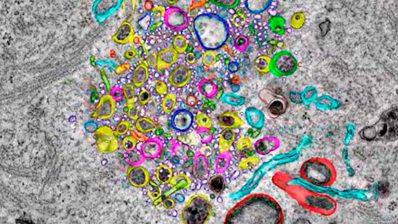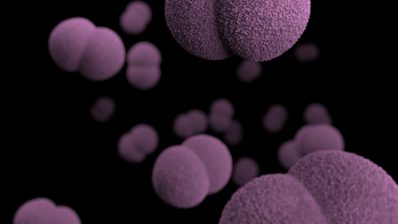In this article of El·lipse you can read some of this week’s research highlights from the centres at the Barcelona Biomedical Research Park (PRBB). You can read the whole stories on the links provided, and if you want to dig even deeper, you can find the original research papers below.
New advances to treat aggressive cancers
Researchers from the Hospital del Mar Medical Research Institute (IMIM) have found a cellular mechanism that can be key for the treatment of metastatic tumors. In their study (1) they showed that the protein kinase IKKα, is involved in the repair of tumor cells. The function of this protein – which is activated by the BRAF and KRAS oncogenes and present in the majority of the most aggressive tumors – is to facilitate the repair of the DNA damage caused by chemotherapy, a fact that makes them more resistant to the action of these drugs. The researchers implanted mice with colon tumors from human patients who had developed metastasis and resistance to treatment. The combination of BRAF inhibitors and chemotherapy was able to eliminate cancer cells. The authors now want to start a clinical trial in cancer patients.
Recently, another study (2) led by researchers from both the IMIM and the Department of Experimental and Health Sciences, Pompeu Fabra University (DCEXS-UPF)), identified a possible marker of resistance to treatment in breast cancer: the aging NK lymphocytes circulating in the blood of patients with HER2-positive breast cancer. The results of the study suggest that women with more aged NK cells at the moment of diagnosis have higher probabilities of being resistant to treatment with chemotherapy and anti-HER2 antibodies.
The three-dimensional genomic structure gains importance
The 3D organization of the genome in male germ cells has been revealed in a study (3) led by scientists from the Autonomous University of Barcelona (UAB) and the Centre for Genomic Regulation (CRG). The work, carried out in mice, shows that this organization is extremely dynamic during the formation of germ cells (precursors of gametes) and that this dynamism is coupled with the regulation of gene expression and the localization of structural proteins such as cohesin.
Another study (4) of the CRG, led by Irene Miguel-Escalada and Jorge Ferrer, has created a three-dimensional map of the genome that allows the discovery of genetic mechanisms associated with the development of type 2 diabetes (DM2). The study has shown that DNA regions involved in type 2 diabetes and apparently isolated when looking at the linear sequence of the genome, are actually in contact with other genes when the 3D genome is observed.
The composition of the microbiome of human skin can be modulated
Researchers from the Department of Experimental and Health Sciences, Pompeu Fabra University (DCEXS-UPF) and S-Biomedic have demonstrated that the microbial composition of the skin can be modulated (5). For the study, researchers prepared probiotic solutions from donor microbiomes and applied them to 18 healthy volunteers aged between 22 and 42 years. They show that after periodic applications of a donor microbiome, the recipient microbiome becomes more similar to the donor. The level of success depends on the composition of both microbiomes and the bacterial load applied. This method opens the possibility of developing probiotic solutions that help the human skin to move from microbial states typical of disease to healthy ones.
Genetic variants may increase susceptibility to methylmercury during pregnancy
When mercury enters oceans, lakes or rivers, it is converted into methylmercury by bacterial action and accumulates in fish and shellfish. A study (6) led by the Barcelona Institute for Global Health (ISGlobal) shows that, although prenatal exposure to low levels of methylmercury does not generally affect cognition in childhood, children with certain genetic variants have increased susceptibility. The principal investigator, Jordi Júlvez, emphasizes that “30% of children in the general population carry these genetic variants and therefore may be more vulnerable to prenatal exposure to methylmercury, even in low exposure conditions”.
(1) Carlota Colomer, Pol Margalef, Alberto Villanueva, Anna Vert, Irene Pecharroman, Laura Solé, Mónica González-Farré, Josune Alonso, Clara Montagut, Maria Martinez-Iniesta, Joan Bertran, Eva Borràs, Mar Iglesias, Eduard Sabidó, Anna Bigas, Simon J. Boulton & Lluís Espinosa. IKKα kinase regulates the DNA damage response and drives chemo-resistance in Cancer. Mol Cell 2019
(2) Muntasell A, Servitja S, Cabo M, Bermejo B, Perez-Buira S, Rojo F, Costa-Garcia M, Arpí O, Moraru M, Serrano L, Tusquets I, Martínez MT, Heredia G, Vera A, Martínez-García M, Soria L, Comerma L, Santana-Hernández S, Eroles P, Rovira A, Vilches C, Lluch A, Albanell J*, López-Botet M. High numbers of circulating CD57+ NK cells associate with resistance to HER2-specific therapeutic antibodies in HER2+ primary breast cancer. Cancer Immunol Res 2019.
(3) Covadonga Vara, Andreu Paytuví-Gallart, Yasmina Cuartero, François Le Dily, Francisca Garcia, Judit Salvà-Castro, Laura Gómez-H, Eva Julià, Catia Moutinho, Riccardo Aiese Cigliano, Walter Sanseverino, Oscar Fornas, Alberto M. Pendás, Holger Heyn, Paul D. Waters, Marc A. Marti-Renom, Aurora Ruiz-Herrera. Three-Dimensional Genomic Structure and Cohesin Occupancy Correlate with Transcriptional Activity during Spermatogenesis. Cell Reports VOLUME 28, ISSUE 2, P352-367.E9, JULY 09, 2019.
(4) Irene Miguel-Escalada et al. Human pancreatic islet three-dimensional chromatin architecture provides insights into the genetics of type 2 diabetes. Nature Genetics volume 51, pages 1137–1148 (2019).
(5) B Paetzold, J R. Willis, J Pereira de Lima, N Knödlseder, H Brüggemann, S R. Quist, T Gabaldón and M Güell. Skin microbiome modulation induced by probiotic solutions. Microbiome, June 2019. DOI: 10.1186/s40168-019-0709-3.
(6) Júlvez J, Smith GD, Ring S and P Grandjean. A birth cohort study about the genetic modification of prenatal methylmercury association with child cognitive development. American Journal of Epidemiology. July 2019. https://doi.org/10.1093/aje/kwz156






